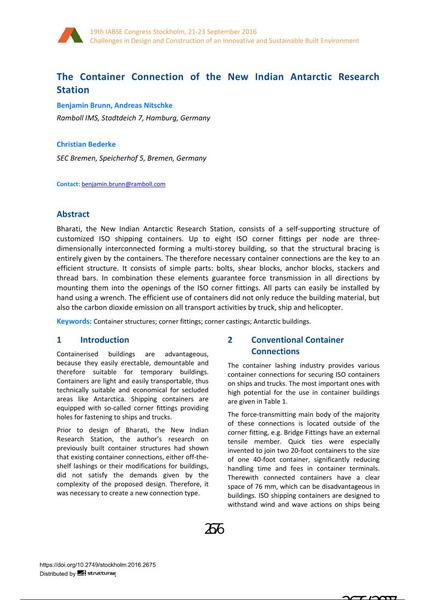The Container Connection of the New Indian Antarctic Research Station

|
|
|||||||||||
Bibliografische Angaben
| Autor(en): |
Benjamin Brunn
(Ramboll IMS, Stadtdeich 7, Hamburg, Germany)
Andreas Nitschke (Ramboll IMS, Stadtdeich 7, Hamburg, Germany) Christian Bederke (SEC Bremen, Speicherhof 5, Bremen, Germany) |
||||
|---|---|---|---|---|---|
| Medium: | Tagungsbeitrag | ||||
| Sprache(n): | Englisch | ||||
| Tagung: | IABSE Congress: Challenges in Design and Construction of an Innovative and Sustainable Built Environment, Stockholm, Sweden, 21-23 September 2016 | ||||
| Veröffentlicht in: | IABSE Congress Stockholm, 2016 | ||||
|
|||||
| Seite(n): | 2676-2684 | ||||
| Anzahl der Seiten (im PDF): | 9 | ||||
| Jahr: | 2016 | ||||
| DOI: | 10.2749/stockholm.2016.2675 | ||||
| Abstrakt: |
Bharati, the New Indian Antarctic Research Station, consists of a self-supporting structure of customized ISO shipping containers. Up to eight ISO corner fittings per node are three- dimensionally interconnected forming a multi-storey building, so that the structural bracing is entirely given by the containers. The therefore necessary container connections are the key to an efficient structure. It consists of simple parts: bolts, shear blocks, anchor blocks, stackers and thread bars. In combination these elements guarantee force transmission in all directions by mounting them into the openings of the ISO corner fittings. All parts can easily be installed by hand using a wrench. The efficient use of containers did not only reduce the building material, but also the carbon dioxide emission on all transport activities by truck, ship and helicopter. |
||||

